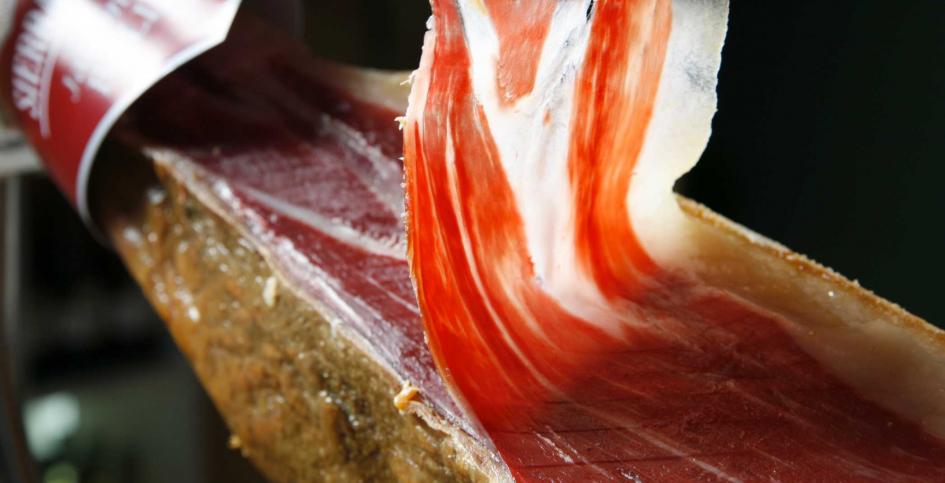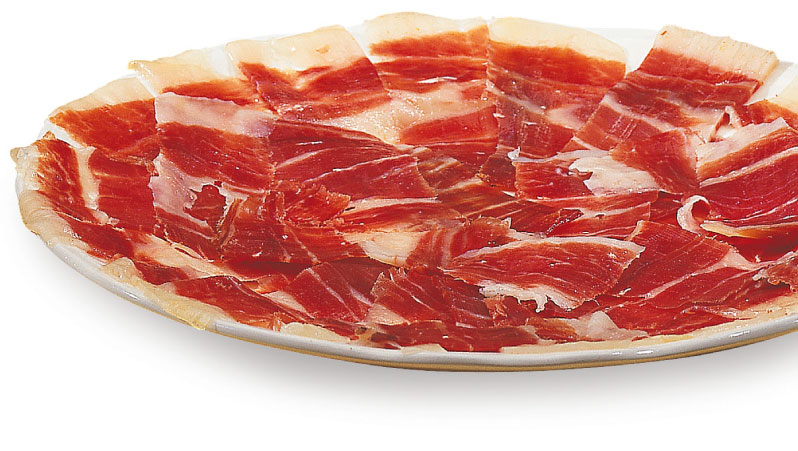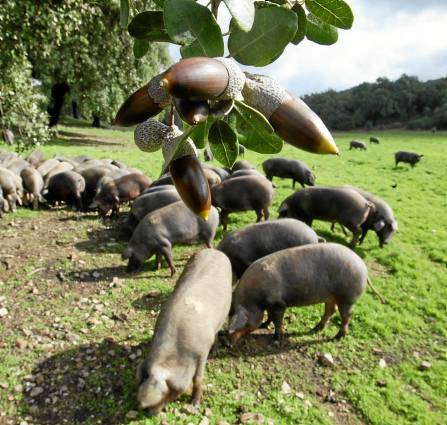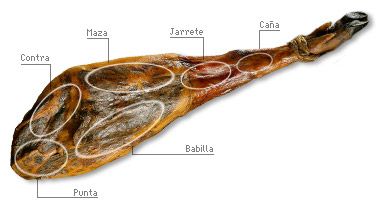Apart from extra virgin olive oil another of my favourites from the Spanish culinary world is cured ham, in particular, Iberian Acorn Ham (Jamon de Bellota Iberica). Which is very different from Serrano Ham or the Italian Prosciutto and is unique to Spain. It is an absolute delicacy and one of the most moreish foods you will encounter!

Fresh meat has been preserved throughout history and the pig has always played a particularly important role in this practice. This is partly because of its high reproductive capacity, and also due to the varying uses that can be made of its meat and the ease of storing and processing it. The great Mediterranean tradition for cured hams and cold meat products is believed to have originated with the Romans and Greeks as reflected in names such as "longaniza" (cured pork sausage) and "salchicha" (sausage) that come from the Roman lucanica and salsicius. The Mediterranean Diet is more than simply a sum of particular ingredients or recipes and makes better sense when associated with the climate, geography, customs and lifestyles in Mediterranean areas. Iberian Bellota Ham plays a key role in this kind of diet. Not only is it tasty and succulent, but it also has specific properties that make it a unique food product and thus stands out from the other cured hams available throughout the Mediterranean Basin.

Iberian Bellota Ham is a low-calorie food, which is rich in vitamins and contains 50% more protein than fresh meat. A particularly surprising fact! Due to the natural and traditional curing process, Iberian acorn ham is a pure and aseptic food and the meat is free from any kind of manipulation. Iberian acorn ham is not just a food product, but also a delicacy with numerous other qualities. As well as being a pleasure for the palate, it also offers great health benefits. Iberian ham is full of antioxidants and is high in vitamin E. It is especially beneficial when eaten with tomatoes. Iberian bellota ham contains excellent quality fat, with increased levels of oleic acid (over 50%), as found in olive oil. This facilitates the production of HDL ("good cholesterol") in the body, while reducing LDL ("bad cholesterol"). So when you start to combine extra virgin olive oil, Bellota Ham and other ingredients you can see suddenly how the Spanish diet is in particular so healthy, take a look at my post on “Pan Catalana”, so simple yet so healthy! For these reasons moderate consumption of the product helps to maintain cholesterol levels and prevent cardiovascular diseases as with extra virgin olive oil.
It provides a generous dosage of B group vitamins, especially B1 and B2. Just 100 grams of Iberian acorn ham provides 24% of the recommended daily allowance of this vitamin. It is also rich in iron, magnesium, zinc and calcium and above all phosphorus, providing 30% of the recommended daily allowance.

It is a recommended food for hypo-calorific diets as 50 grams of our Iberian Bellota Ham has only 150 calories. So is Iberian Bellota ham the same as Jamon de Pata Negra( black hoof ham)? And how does it differ to Serrano Ham? This term “Pata Negra” refers exclusively to races of pigs with black hoofs and does not necessarily refer to Iberian pigs or those of a specific quality as commonly thought. In fact, there are Iberian pigs with different colourings. Serrano ham comes from a white pig which is fed mainly on fodder and is cured for a period of between 7 and 16 months. Gastronomically, serrano jamón is considered inferior to Iberian ham and is dried in a cold dry climate in the hills or mountains.
And Jabugo Ham? Where does this come in? Well, it is a high-quality Iberian Ham which comes from the mountainous region of Huelva. Jabugo is the best known of the mountainous villages. The name comes from the town not the type of ham. Many think cured ham should be salty, and normally find it dry but really if it is fresh and well made it should be juicy and not salty. With regard to the firmness, the ham should be cured to an optimum point, though never too much (this point will vary depending on the part of the ham being cured). One of the differences between a serrano ham and an Iberian ham is the fluidity of the fat. An Iberian ham should always be moister than a serrano and a lot shinier. It is common to see white dots in Iberian hams that may look like imperfections in the product. However, these dots are produced by the crystallisation of the thyroxine, an amino acid derivative of the proteins that experts consider a sure mark of quality and indicative of a long and unhurried maturing process and a sign of the pig having exercised well while in the pasture, as all pigs raised for Iberian acorn ham are free range and feed on acorns.

The main parts of a cured ham are the maza, the contramaza and the babilla. The maza is the part with the most meat and is the richest and most succulent. The babilla has less jamón as it is confined by the femur and coxal bone. This part is less succulent than the maza so it is recommendable to start cutting here if the cured ham is going to be consumed over a period of time. The part known as the jarrete and the caña are usually diced into cubes of cured ham as the meat has a firmer texture and a different taste. Ham must always be eaten at room temperature in order to enjoy all of its sensual nuances. If the ham has been cut and stored in the refrigerator or comes sliced in a packet, take it out of the refrigerator an hour before eating, to allow it to reach the correct temperature.

I highly recommend it, as it is a delicacy you will find hard to live without once tasted!